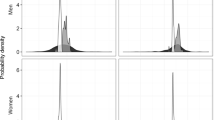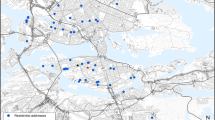Abstract
Epidemiological studies have found negative associations between human health and particulate matter in urban air. In most studies outdoor monitoring of urban background has been used to assess exposure. In a field study, personal exposure as well as bedroom, front door and background concentrations of PM2.5, black smoke (BS), and nitrogen dioxide (NO2) were measured during 2-day periods in 30 subjects (20–33 years old) living and studying in central parts of Copenhagen. The measurements were repeated in the four seasons. Information on indoor exposure sources such as environmental tobacco smoke (ETS) and burning of candles was collected by questionnaires. The personal exposure, the bedroom concentration and the front door concentration was set as outcome variable in separate models and analysed by mixed effect model regression methodology, regarding subject levels as a random factor. Seasons were defined as a dichotomised grouping of outdoor temperature (above and below 8°C). For NO2 there was a significant association between personal exposure and both the bedroom, the front door and the background concentrations, whereas for PM2.5 and BS only the bedroom and the front door concentrations, and not the background concentration, were significantly associated to the personal exposure. The bedroom concentration was the strongest predictor of all three pollution measurements. The association between the bedroom and front door concentrations was significant for all three measurements, and the association between the front door and the background concentrations was significant for PM2.5 and NO2, but not for BS, indicating greater spatial variation for BS than for PM2.5 and NO2. For NO2, the relationship between the personal exposure and the front door concentration was dependent upon the “season”, with a stronger association in the warm season compared with the cold season, and for PM2.5 and BS the same tendency was seen. Time exposed to burning of candles was a significant predictor of personal PM2.5, BS and NO2 exposure, and time exposed to ETS only associated with personal PM2.5 exposure. These findings imply that the personal exposure to PM2.5, BS and NO2 depends on many factors besides the outdoor levels, and that information on, for example, time of season or outdoor temperature and residence exposure, could improve the accuracy of the personal exposure estimation.
This is a preview of subscription content, access via your institution
Access options
Subscribe to this journal
Receive 6 print issues and online access
$259.00 per year
only $43.17 per issue
Buy this article
- Purchase on Springer Link
- Instant access to full article PDF
Prices may be subject to local taxes which are calculated during checkout

Similar content being viewed by others
Abbreviations
- BS:
-
black smoke
- NO2:
-
nitrogen dioxide
- ETS:
-
environmental tobacco smoke
- SEF:
-
standardised effect
References
Abt E., Suh H.H., Catalano P.J., and Koutrakis P. Relative contribution of outdoor and indoor particle sources to indoor concentrations. Environ Sci Technol 2000: 34: 3579–3587.
Brauer M., Hruba F., Mihalikova E., Fabianova E., Miskovic P., Plzikova A., Lendacka M., Vanderberg J., and Cullen A. Personal exposure to particles in Banska Bystrica, Slovakia. J Expos Anal Environ Epidemiol 2001: 10: 478–487.
Brunekreef B., and Holgate S.T. Air pollution and health. Lancet 2002: 360: 1233–1242.
Cocheo V., Boaretto C., and Sacco P. High uptake rate radial diffusive sampler suitable for both solvent and thermal desorption. Am Ind Hyg Assoc 1996: 57: 897–904.
Dockery D.W., Pope III A.C., Xu X., Spengler J.D., Ware J.H., Fay M.E., Ferris Jr B.G., and Speizer F.E. An association between air pollution and mortality in six U.S. cities. N Engl J Med 1993: 329: 1753–1759.
Ebelt S.T., Petkau A.J., Vedal S., Fishe T.V., and Brauer M. Exposure of chronic obstructive pulmonary disease patients to particulate matter: relationship between personal and ambient air concentration. J Air Waste Manage Assoc 2000: 50: 1081–1094.
Gotschi T., Oglesby L., Mathys P., Monn C., Manalis N., Koistinen K., Jantunen M., Hanninen O., Polanska L., and Kunzli N. Comparison of black smoke and PM2.5 levels in indoor and outdoor environments of four European cities. Environ Sci Technol 2002: 36: 1191–1197.
Hoek G., Meliefste K., Cyrys J., Lewne M., Bellander T., Brauer M., Fischer P., Gehring U., Heinrich J., van Vliet P., and Brunekreef B. Spatial variation of fine particle concentrations in three European areas. Atmos Environ 2002: 36: 4077–4088.
Hornung R.W., and Reed L.D. Estimation of average concentration in the presence of nondetectable values. Appl Occup Environ Hyg 1990: 5: 46–51.
Horvath H. Size segregated light absorption coefficient of the aerosol. Atmos Environ 1995: 29: 875–883.
ISO 9835. Determination of a black smoke index in ambient air. British Standard Specifications, 1747[11] 1993.
Janssen N.A., de Hartog J.J., Hoek G., Brunekreef B., Lanki T., Timonen K.L., and Pekkanen J. Personal exposure to fine particulate matter in elderly subjects: relation between personal, indoor, and outdoor concentrations. J Air Waste Manage Assoc 2000: 50: 1133–1143.
Jantunen M.J., Hanninen O., Katsouyanni K., Knoppel H., Kuenzli N., Lebret E., Maroni M., Saarela K., Sram R., and Zmirou D. Air pollution exposure in European cities: The ‘EXPOLIS’ study. J Expos Anal Environ Epidemiol 1998: 8: 495–518.
Jenkins P.L., Phillips T.J., Mulberg E.J., and Hui S.P. Activity patterns of Californians: use and proximity to indoor pollutant sources. Atmos Environ 1992: 26A: 2141–2148.
Kenny L.C., and Gussman R.A. Characterization and modelling of a family of cyclone aerosol preseparators. J Aerosol Sci 1997: 28: 677–688.
Kinney P.L., Aggarwal M., Northridge M.E., Janssen N.A., and Shepard P. Airborne concentrations of PM(2.5) and diesel exhaust particles on Harlem sidewalks: a community-based pilot study. Environ Health Perspect 2000: 108: 213–218.
Koistinen K.J., Hanninen O., Rotko T., Edwards R.D., Moschandreas D., and Jantunen M.J. Behavioral and environmental determinants of personal exposures to PM2.5 in EXPOLIS — Helsinki, Finland. Atmos Environ 2001: 35: 2473–2481.
Kousa A., Monn C., Rotko T., Alm S., Oglesby L., and Jantunen M.J. Personal exposure to NO2 in the EXPOLIS-study: relation to residential indoor, outdoor and workplace concentration in Basel, Helsinki and Prague. Atmos Environ 2001: 35: 3405–3412.
Koutrakis P., and Briggs S.L.K. Source apportionment of indoor aerosols in Suffolk and Onondaga counties, New York. Environ Sci Technol 1992: 26: 521–527.
Levy J.I., Lee K., Spengler J.D., and Yanagisawa Y. Impact of residential nitrogen dioxide exposure on personal exposure: an international study. J Air Waste Manage Assoc 1998: 48: 553–560.
Long C.M., Suh H.H., Catalano P.J., and Koutrakis P. Using time- and size-resolved particulate data to quantify indoor penetration and deposition behavior. Environ Sci Technol 2001a: 35: 2089–2099.
Long C.M., Suh H.H., Kobzik L., Catalano P.J., Ning Y.Y., and Koutrakis P. A pilot investigation of the relative toxicity of indoor and outdoor fine particles: in vitro effects of endotoxin and other particulate properties. Environ Health Perspect 2001b: 109: 1019–1026.
McConnell R., Berhane K., Gilliland F., Molitor J., Thomas D., Lurmann F., Avol E., Gauderman W.J., and Peters J.M. Prospective study of air pollution and bronchitic symptoms in children with asthma. Am J Respir Crit Care Med 2003: 168: 790–797.
Ozkaynak H., Xue J., Spengler J., Wallace L., Pellizzari E., and Jenkins P. Personal exposure to airborne particles and metals: results from the Particle TEAM study in Riverside, California. J Expos Anal Environ Epidemiol 1996: 6: 57–78.
Pellizzari E., Clayton C.A., Rodes C., Mason R.E., Piper L.L., Fort B., Pfeifer G., and Lynam D. Particulate matter and manganese exposure in Toronto, Canada. Atmos Environ 1999: 33: 721–734.
Pope C.A., Burnett R.T., Thun M.J., Calle E.E., Krewski D., Ito K., and Thurston G.D. Lung cancer, cardiopulmonary mortality, and long-term exposure to fine particulate air pollution. JAMA 2002: 287: 1132–1141.
Pope C.A., Thun M.J., Namboodiri M.M., Dockery D.W., Evans J.S., Speizer F.E., and Heath Jr C.W. Particulate air pollution as a predictor of mortality in a prospective study of U.S. adults. Am J Respir Crit Care Med 1995: 151: 669–674.
Rodes C.E., Lawless P.A., Evans G.F., Sheldon L.S., Williams R.W., Vette A.F., Creason J.P., and Walsh D. The relationships between personal PM exposures for elderly populations and indoor and outdoor concentrations for three retirement center scenarios. J Expos Anal Environ Epidemiol 2001: 11: 103–115.
Roosli M., Theis G., Staehelin J., Mathys P., Oglesby L., Camenzind M., and Braun-Fahrlander C. Temporal and spatial variation of the chemical composition of PM10 at urban and rural sites in the Basel area, Switzerland. Atmos Environ 2001: 35: 3701–3713.
Seaton A., Soutar A., Crawford V., Elton R., McNerlan S., Cherrie J., Watt M., Agius R., and Stout R. Particulate air pollution and the blood. Thorax 1999: 54: 1027–1032.
Sorensen M., Autrup H., Hertel O., Wallin H., Knudsen L.E., and Loft S. Personal exposure to PM2.5 and biomarkers of DNA damage. Cancer Epidemiol Biomarkers Prev 2003a: 12: 191–196.
Sorensen M., Daneshvar B., Hansen M., Dragsted L.O., Hertel O., Knudsen L., and Loft S. Personal PM(2.5) exposure and markers of oxidative stress in blood. Environ Health Perspect 2003b: 111: 161–166.
Thatcher T.L., and Layton D.W. Deposition, resuspension, and penetration of particles within a residence. Atmos Environ 1995: 29: 1487–1497.
Vignati E., Berkowicz R., Palmgren F., Lyck E., and Hummelshøj P. Transformation of size distributions of emitted particles in streets. Sci Total Environ 1999: 235: 37–49.
Wallace L. Indoor particles: a review. J Air Waste Manage Assoc 1996: 46: 98–126.
Williams R., Suggs J., Creason J., Rodes C., Lawless P., Kwok R., Zweidinger R., and Sheldon L. The 1998 Baltimore Particulate Matter Epidemiology — Exposure Study: part 2. Personal exposure assessment associated with an elderly study population. J Expos Anal Environ Epidemiol 2000: 10: 533–543.
Acknowledgements
Financial support was obtained from the Danish National Environmental Research Programme under the Centre for the Environment and the Respiratory System (CML).
Author information
Authors and Affiliations
Corresponding author
Rights and permissions
About this article
Cite this article
Sørensen, M., Loft, S., Andersen, H. et al. Personal exposure to PM2.5, black smoke and NO2 in Copenhagen: relationship to bedroom and outdoor concentrations covering seasonal variation. J Expo Sci Environ Epidemiol 15, 413–422 (2005). https://doi.org/10.1038/sj.jea.7500419
Received:
Accepted:
Published:
Issue Date:
DOI: https://doi.org/10.1038/sj.jea.7500419
Keywords
This article is cited by
-
Airway and systemic biomarkers of health effects after short-term exposure to indoor ultrafine particles from cooking and candles – A randomized controlled double-blind crossover study among mild asthmatic subjects
Particle and Fibre Toxicology (2023)
-
Association between outdoor air pollution and chronic rhinosinusitis patient reported outcomes
Environmental Health (2022)
-
Assessment of indoor air pollutant concentrations and emissions from natural gas cooking burners in residential buildings in Tehran, Iran
Air Quality, Atmosphere & Health (2020)
-
Exposure to air pollutants among cyclists: a comparison of different cycling routes in Perth, Western Australia
Air Quality, Atmosphere & Health (2020)
-
Richtwerte für Stickstoffdioxid (NO2) in der Innenraumluft
Bundesgesundheitsblatt - Gesundheitsforschung - Gesundheitsschutz (2019)



